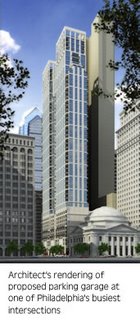 One of my favorite blogs is Skyline Online, by the Philadelphia Inquirer architecture critic, Inga Saffron. Saffron's postings and the discussions that follow range from the aesthetics of new buildings to Philadelphia city planning to climate change and back—a stimulating and worthwhile experience for anyone concerned about these issues.
One of my favorite blogs is Skyline Online, by the Philadelphia Inquirer architecture critic, Inga Saffron. Saffron's postings and the discussions that follow range from the aesthetics of new buildings to Philadelphia city planning to climate change and back—a stimulating and worthwhile experience for anyone concerned about these issues.A recent Skyline Online posting reported that a Philadelphia developer, unable to find enough potential tenants for a proposed condominium at 15th and Chestnut Streets, had now decided to build the project in two stages: a "beautiful" (the developer's word) ten-story parking garage in the next two years, and the rest of the condominium later.
Two-stage projects like this in Philadelphia—and presumably in most cities—tend to remain at Stage 1 indefinitely. In effect, the developer was proposing to build a permanent parking garage at one of the busiest intersections in downtown Philadelphia (Center City, in local terminology). The local planning commission, which seems to love parking above all else, was likely to approve the two-stage project, although the newly-appointed city planning commissioner later said that because planners had approved the garage only as part of the condominium project, approval would not necessarily be a foregone conclusion.
Comments on the posting range from those who saw the proposal as a disaster to those who argued that the building itself looked nice and that more parking was an unalloyed benefit because no one from the suburbs would come to Center City unless they could park. My own position was the former—in fact, I was the first to use the term "disaster."
The whole discussion raised a deeper question: What does it now mean to say that a building (or a city block, or a machine like an automobile, train, or bus) is well-designed? The parking garage makes a pretty picture in the architect's rendering, although whether it harmonizes well with the buildings near it is hard to tell. But its impact on the environment, both natural and man-made, is likely to be very unattractive indeed. Is a nice building that destroys the natural environment and causes more traffic congestion really well-designed?
That is a hard question, too hard for one short posting. The scientific consensus is that every additional mile we drive places greater and greater burden on the environment. This is true both of private cars and of buses without adequate pollution controls—but the private car is far less efficient at moving people than the bus. And both transport modes are less efficient, and therefore more of an environmental hazard, than rail.
Can a building that is beautiful (or at least not ugly) really be well-designed if it does not take into account its overall impact? And how do we balance the environmental destruction that one more parking garage will encourage with the potential loss of business from suburban dwellers who will not visit the city unless they can drive there and park?
It is not an easy balance to strike. I have no clear answer. But in the next two postings, I will try to weigh the factors and consider them in the larger context of the future of climate change and resource limitations which is moving toward us faster than we could have imagined even five years ago.


No comments:
Post a Comment